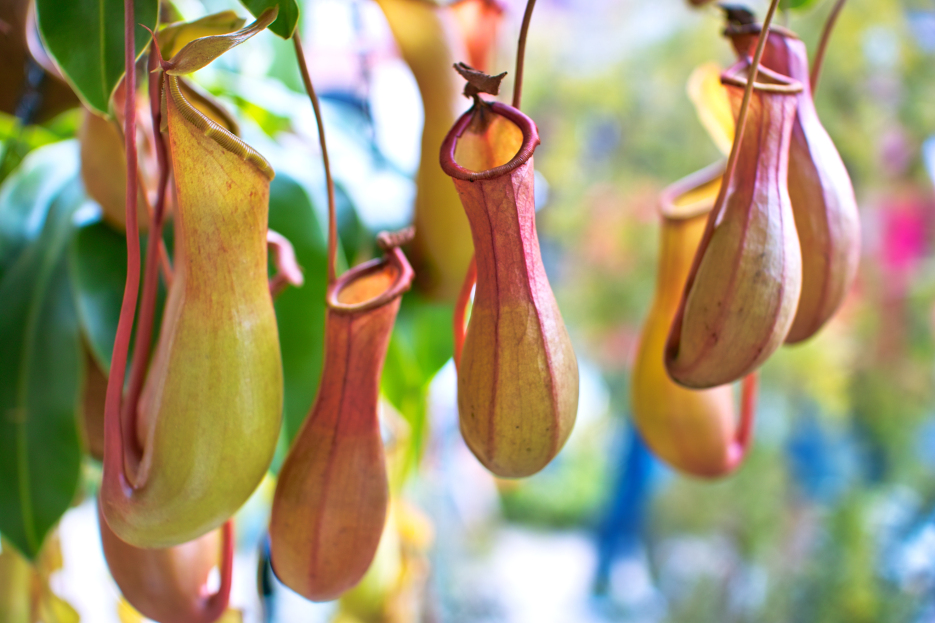
Pitcher plants (Sarracenia, Nepenthes, and other genera) are fascinating carnivorous plants known for their unique, tubular “pitchers” that trap and digest insects. These plants are not only visually striking but also an excellent conversation starter for your indoor garden. While pitcher plants can seem intimidating due to their carnivorous nature, they are relatively easy to care for as long as you meet their specific needs. Whether you’re growing a Sarracenia (North American variety) or a Nepenthes (tropical variety), here’s everything you need to know about caring for your pitcher plant houseplant.
Pitcher plants thrive in bright, indirect sunlight, but they can also tolerate some direct sunlight. For the best results, place your pitcher plant in a location that receives at least 4-6 hours of bright, indirect sunlight each day. A south- or west-facing windowsill is ideal. If you have a tropical variety like Nepenthes, it may require slightly less direct sunlight, as it originates from shaded forest environments.
If your pitcher plant isn’t receiving enough light, it may become leggy, with fewer or smaller pitchers. On the other hand, too much direct sunlight can cause the plant to scorch. Finding a balance between bright indirect light and direct sunlight is key.
Pitcher plants are sensitive to minerals found in tap water, so it’s essential to water them with distilled water, rainwater, or purified water. Tap water often contains salts and minerals that can harm these plants, leading to poor health or even death.
Keep the soil consistently moist, but avoid waterlogging the plant. You can water your pitcher plant by placing it in a tray of water, allowing the soil to absorb moisture from the bottom. If you’re growing a tropical variety, Nepenthes, they may prefer slightly more humidity, so it’s important to keep the soil damp, especially during the warmer months.
During the growing season (spring and summer), you may need to water your plant more frequently, while in the dormant winter months, you can reduce watering. Always check the moisture level of the soil before watering to ensure it’s not too wet or too dry.
Pitcher plants thrive in high humidity, especially tropical varieties like Nepenthes. If the air in your home is too dry, you can increase humidity by placing a humidity tray under the plant or using a room humidifier. The ideal humidity level for pitcher plants is between 50-60%. In dry conditions, pitcher plants may stop producing pitchers or have smaller, weaker traps.
As for temperature, pitcher plants prefer warm conditions, with most species thriving between 70°F and 85°F (21°C to 29°C) during the growing season. They can tolerate cooler temperatures during the dormant period, but they should not be exposed to freezing temperatures.
Pitcher plants require nutrient-poor, acidic soil that drains well. The best soil mix for these plants is a combination of sphagnum moss and perlite or sand. This mix mimics the conditions found in their natural habitats, such as bogs and wetlands, where the soil is acidic and low in nutrients.
Avoid using regular potting soil, as it is too rich in nutrients and may harm your plant. When choosing a plant pot, make sure it has drainage holes to prevent the plant from sitting in water, which can lead to root rot. A plastic or glazed ceramic pot is a good choice because it retains moisture without drying out too quickly.
Pitcher plants are carnivorous and rely on insects for nutrients. In their natural habitat, they catch bugs that fall into their specialized pitcher-shaped leaves, where the plant secretes digestive enzymes to break down the prey. If you’re growing a pitcher plant indoors, you may need to supplement its diet with insects.
You can feed your pitcher plant small insects like flies, ants, or spiders. Place the insect directly into the pitcher, and the plant will do the rest. Avoid feeding the plant large insects or processed food, as this can damage the pitcher or harm the plant. If you’re unable to provide insects, pitcher plants can survive on sunlight and water alone, though they will grow more slowly without a regular food source.
To keep your pitcher plant healthy and looking its best, remove any dead or dried-up pitchers regularly. Pruning helps prevent the spread of disease and encourages the growth of new, healthy pitchers. You can also trim any dead or yellowing leaves to maintain the plant’s appearance.
You may need to repot your plant every 1-2 years to refresh the soil and provide more space for growth. Repotting is best done in the spring, just before the growing season begins.
Some pitcher plants, particularly Sarracenia (North American varieties), require a period of dormancy during the winter months. During this time, the plant’s growth slows down, and the pitchers may die back. This is a natural process, and the plant will regenerate new growth in the spring.
To encourage dormancy, reduce watering and move the plant to a cooler location (between 32°F and 50°F or 0°C to 10°C) for 3-4 months. You can place it in a cool basement, garage, or unheated room. Keep the soil slightly damp during dormancy, but do not overwater. After the dormancy period, bring the plant back to its normal growing conditions, and it should begin to grow new pitchers.
You can propagate pitcher plants (Sarracenia, Nepenthes, or Heliamphora) using several methods, including seed propagation, division, and cuttings. The best method depends on the type of pitcher plant you have.
Pitcher plants are non-toxic to pets, making them safe to keep in homes with cats and dogs. However, as the plant uses its traps to catch insects, curious pets may be attracted to the plant. While the traps won’t harm your pets, it’s a good idea to keep the plant out of reach to prevent any accidental damage to the plant or the traps.